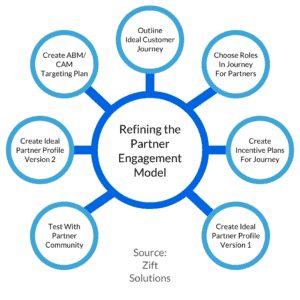There’s not one right way – or even a prevailing method– to recruit channel sales partners. Companies that thrive in the channel get there through many paths – none of which are magic bullets for channel success. In fact, to a layperson, success may appear to be random; firms that struggle in the channel often appear to be modeling similar approaches to competitors that achieve success.
This is because channel success is complicated and requires a more profound commitment than pushing products and payouts. Those factors matter, to be sure, but capturing and retaining channel sales partners is a complex process that touches every aspect of a provider’s business. Success and failure can occur at multiple touchpoints between your firm and your (potential and current) partners that encompass facets of your entire operation.
10 Key Strategies to Recruit Productive Sales Partners
Tip 1: Understand the Ideal Customer Profile Before You Understand Your Ideal Channel Partner Profile
The experts at Zift have consulted with dozens of channel programs over the years and most companies have not defined their ideal customer profile, even when they believe they have. Separate departments in the company may have differing ideas on their ideal target client. You need to know your ideal customer profile (ICP) before establishing your ideal partner profile (IPP) since the partner will typically be a gateway to the sale to the end customer.
Here are questions to answer with your team when determining your ideal customer profile:
- What would a customer buy from you?
- What problems do your products or services solve?
- What business advantages do your solutions provide?
- What is the age of your typical customer?
- What is the gender of your typical customer?
- Where do your typical customers live geographically?
- How do your customers make money?
- In what industries or verticals do your customers typically operate?
- What are your customer’s pain points, and does your product or service address them?
- Why would they buy your services over those of a competitor?
- What are the most common or popular types of services you offer that your clients purchase?
- What factors are your customers likely to consider before the purchase?
- What do customers tell you they value about your services?
- How do your customers typically discover your product or service?
- How does the cost of your product or service influence your customers’ decision to buy?
- What is your typical customers’ preferred method of communication?
Based on the answers to these questions, you’ll have a clear idea of your target customer and how best to reach them. From here, you need to determine what other companies serve these customers and if there’s an opportunity to partner with them to deliver your services.
Tip 2: Focus on the Channel Partner, Not Your Company
Solutions selling isn’t new to technology providers. It’s central to their internal direct marketing practices and how they coach their partners in their go-to-market strategies. But that same approach is often overlooked in channel partner recruitment – particularly by big brands that think partners should feel privileged to represent them. Providers that have built demonstrably better marketplace solutions can fall into the trap of pushing products over partnerships.
To be fair, both viewpoints have merit. Partners sometimes encounter brand-sensitive clients, and cutting-edge solutions can open doors or tilt deals in the right circumstances. When institutionalized, however, those limited perspectives miss the mark with partners in the same way that “product pushers” lose out to “problem solvers” when selling to end customers.
The provider-centric approach is why the mix of brands that thrive in the channel differs from the pool of market leaders that sell direct. There are some “channel-friendly” market leaders, but there also are many smaller companies that have established brand and revenue leadership within the channel through a relentless focus on the issues their channel partners face. Their channel commitment runs deeper than building strong pre-and post-sales support (though both are vital); they strive to understand the business challenges of their partners.
Some organizations will adopt a four-pronged “FIST” strategy for partner management:
Financial benefit to the partner.
What is the value of your products and services to the partner? How do they make money with them?
Integrity of your organization.
How do you position yourselves as trustworthy? It’s more than reviews or being a public company.
Sincerity of your personnel.
Do your people genuinely care and like working with their partners? Authenticity creates a healthier engagement and should never be undervalued in recruiting and retaining partners.
Transparency in your communication.
You must over-communicate and never assume your partner knows the information you haven’t explicitly communicated.
Tip 3: Develop Your Ideal Channel Partner Profiles
All partners are not created equally. Some are high performers, some can be nurtured into becoming high performers, and some have limited potential. Knowing the difference and how to screen for the right partners can save you a lot of headaches and wasted investment.
An easy answer to the question of what makes an ideal partner is one whose organization is aligned with your sales, marketing, provisioning and support—these respective departments, when aligned, deliver an extension of each other for a true partnership. Vendors and partners who genuinely believe in each other’s capabilities and competency in growing, serving and supporting customers jointly are necessary to ensure a successful engagement.
A supplier’s ideal partner knows their ideal customer. They need to have a mature understanding of their own offer and ideal customer profile. Without that, it will be challenging to determine how your solution fits into their go-to-market strategy.
The effort to profile and screen for an ideal partner pays off—especially since it could take six to 12 months (depending on the length of your sales cycle) before you have a good read on a new partner’s performance.
Tip 4: Find New Partners Where They Gather – Online or In-Person
“The channel” is an industry unto itself — and a complicated one at that. Your potential partners attend conferences, read industry publications like CRN and Channel Futures, listen to podcasts, attend webinars, and participate in LinkedIn groups—you name it. They do everything other businesses do to grow their companies and refine their operations.
Just as channel partners with vertical industry expertise meet their customers where they gather, you need to build your brand, develop your leads and build your community where your partners meet.
Answer the following questions to help you narrow down your focus:
- Who are your customers?
- What in-person and virtual events are they attending?
- What magazines do they read?
- In what webinars/podcasts/groups are they participating?
- Who do they follow that influences them?
The answers to these questions may not be straightforward, particularly since technology convergence means your next best partner may look nothing like the ones you’ve worked with in the past. For example, SaaS or emerging tech partners may not frequent the usual IT partner haunts (and may not even know about them). You need to find out where they’re spending their time.
Tip 5: Use Technology Services Brokerages (TSBs) & Distributors to Reach Top-Performing Sales Partners
TSBs and other distributors can bring a lot of value to the table, including access to top-performing sales partners. They help to manage compensation, partner service inquiries and training on your company’s solutions. The larger agencies even have their own partner conferences that deliver opportunities to interact with highly engaged partners.
TSB engagement can have a high value in specific provider’s channel strategies. Develop a strong “sell-with” relationship with TSBs that give you access to their top-performing sales agents. Then allow those same agents to train, certify and earn aggressive residual commissions on opportunities sold.
While TSB agencies can be tremendous allies in connecting your company with top partners, they also can be gatekeepers, ensuring that only vendors offering the best channel agreements, service performance and customer experience get access to their best sales agents. Make sure that you’ve checked all the boxes.
Tip 6: Follow Up with Leads Fast
A reliable channel partner can be a gift that keeps on giving. Of course, you know that already, which is why you’re here. Your competitors also know it, and they collect the same emails at networking events. The prospective partners you talk with may enjoy being the belles of the ball, but their many suitors quickly become a blur. And when they get back from the event and receive follow-up emails, they’re overwhelmed after the first few and begin deleting the rest or dragging them to their junk folders.
In other words, you want to be in their first wave of follow-ups. Of course, you need to attend these events, but that will not cut it. Good suppliers make an impression at events and then after they leave. You can’t wait. Follow up in a week, or they’ll forget you.
In our hyper-digital world, channel sales managers who are first out of the gate request to connect with partners on LinkedIn immediately after meeting them and while the event is still in progress. A personalized note in the moment can help get that critical second meeting on the books. In an ideal world, your follow-up meeting with the partner prospect is already set before you leave the event.
Tip 7: Show Value to Partners – How You Help Them and Their Customers
Having solid presales support to help your partners close deals is imperative to building a strong reputation in the channel. So is reliable and pain-free provisioning and onboarding of your channel partners’ customers. Post-sale support? Yeah, you’ve got to deliver. And your billing needs to be correct, and your commissions need to be accurate and on time.
Getting customer- and partner-side processes down pat is essential to building a solid channel reputation (and avoiding a poor one). But that’s only the cost of entry. Offering something new and valuable to your partners will get you noticed and keep them engaged after they sign on.
By focusing on the unique value you offer partners, you can pique their interest and avoid the “me too” trap of trying to convince them to displace their current providers by engaging in SPIFF and commissions wars for “bread and butter” product sales. Besides, being the highest bidder isn’t a winning long-term channel strategy; it only works until a better offer comes along and attracts partners more concerned about their bank accounts than their customer accounts.
Ask yourself these questions:
- What is our value proposition?
- What solution for an approach to customers or products are we giving them that they didn’t have previously?
- How are we bringing them new customers they didn’t have previously?
Tip 8: Prioritize Responsiveness to Build Trust and Keep Partners Engaged
Price always matters. Let’s not pretend it doesn’t. In addition to price, the value propositions of most of today’s technology sales are centered firmly on solving business challenges like overtaxed resources, operational headaches and problems that can cause customer dissatisfaction and revenue loss. Channel partners engage in this arena daily, mixing and matching the services they sell to help their customers tackle various issues.
But as soon as they leave a client site or close a ticket, channel partners face many of those issues themselves. They’ve got all the overhead and responsibilities of any other business – HR, payroll, accounting, sales and marketing, etc. – but are at the mercy of the providers they work with to keep their customers up and running (and satisfied).
This is where responsiveness can set you apart from your competitors. The faster your sales support operations can quote services or your channel account managers can resolve issues for your partners and their clients, the more trust you build in the relationship. That’s because you make your partners look good to their customers and reduce their workload while you do it.
Go the extra mile in providing what your customers, prospects, and partners are asking for, and ensure that you are responsive to them. Everybody has choices these days, and you’ll deal with someone faster if they are responsive. It all comes back to the customer experience and meeting the partner’s needs.
Tip 9: Assess and Refine Partner Engagement Model
Assessment is vital to building and maintaining strong channel partner recruitment and engagement. Develop and test partner incentives and participation directly before launching campaigns.
 In terms of measuring partner performance, detailed quarterly business reviews can help you test your partner profiles to ensure they’re performing as expected. You’ll see which products are performing best for your base on the one hand, and on the other, you see which partners are performing the best with your products.
In terms of measuring partner performance, detailed quarterly business reviews can help you test your partner profiles to ensure they’re performing as expected. You’ll see which products are performing best for your base on the one hand, and on the other, you see which partners are performing the best with your products.
Periodic reviews also can help you identify partners that are not engaging or that may have been poached by your competitors, as well as any changes in the competitive environment that require attention.
Tip 10: Know When to Say No to a New Partner or Invest Further in an Existing One
Depending on the length of your sales cycle, you’re taking a six- to 12-month bet that the financial, human and opportunity cost of recruiting a partner will pay off. That means you want to do all you can to tip the odds in your favor.
Use best-fit partners to model an ideal partner profile and stick to it. Don’t be afraid to tell a prospective partner “No.”
Similarly, if a partner is not engaged, not performing and slow to respond to your outreach or uninterested in opportunities you provide to up their game, focus your resources elsewhere. Spend your time and energy on partners who share your goals and values and who want success as much as you do.
Stop banging your head against the wall. Sometimes, it’s simply a matter of misalignment between your objectives and your partner’s objectives. The most talented channel leaders in the world know when to say no or manage differently. Don’t waste time or set yourself up for disappointment by forcing your partners to fit into your definition of success.
While there’s no copy-and-paste method for finding the right partners, keeping these tips in mind while developing your channel partner recruitment strategy can set you on the right path. Capturing (and retaining) the best partners for your organization will set the foundation for your channel’s success.
A Comprehensive Guide to Channel Sales – Download
Are you interested in learning more about the ins and outs of channel sales? You’ll want to download our comprehensive, FREE guide at the button below.
Our Guide to Channel Sales covers what you need to know about channel sales models and how to build and activate your channel sales network.
Kelsey Worsham
Kelsey is the Senior Content Marketing and Communications Manager at Zift Solutions.




